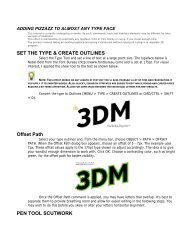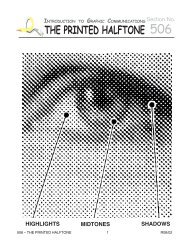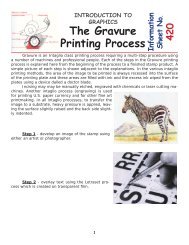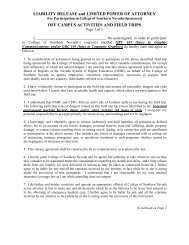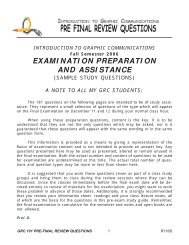AAA 207-GRC 101 - LETTER SPACING AND SET WIDTH
AAA 207-GRC 101 - LETTER SPACING AND SET WIDTH
AAA 207-GRC 101 - LETTER SPACING AND SET WIDTH
Create successful ePaper yourself
Turn your PDF publications into a flip-book with our unique Google optimized e-Paper software.
Read My Quips<br />
There’s only one problem with this fashion<br />
in setting type: It’s usually not very readable. In<br />
the hands of a master (Herb Lubalin was a master<br />
of this art), it can be brilliant and it can work<br />
(see figure 2); in the hands of most practitioners,<br />
however, it produced a mishmash of crowded,<br />
cacophonous lettering that lost its impact and<br />
failed to communicate.<br />
The basic fact of contrast — which is how<br />
we see and read letters — is that it has two<br />
parts: the background, and the object that’s<br />
against the background. Without the background,<br />
there would be no way to recognize the<br />
object, since there would be no differentiation,<br />
no contrast, no edges, no shape. The most traditional<br />
form of printing is black marks on white<br />
paper: letters against a contrasting background.<br />
The marks can be red or gray or blue or brown,<br />
Figure 2: Kids! Don’t try this at home with type of your<br />
own! (From the June 1977 issue of “U&lc.”)!<br />
and the background might be yellow or green or<br />
black, but there must be a visible contrast between<br />
the two.<br />
you squeeze out all the space between letters,<br />
you lose that balance, and you render the words<br />
harder to read (see figure 3).<br />
Figure 3: Squeezing all the air out between letters, vs. giving<br />
the type some room to breathe.<br />
(It’s been said often that we read more by<br />
recognizing the shapes of words than by recognizing<br />
individual letters. There’s a lot of truth to<br />
this. That’s why it’s easier to read words in lowercase<br />
letters, which have ascenders and descenders,<br />
than in capital letters, which all have<br />
the same height. But the shape we read isn’t<br />
just the outline of the word; it includes the pattern<br />
of lines and spaces within the word, too. In<br />
reality, our eyes and our brains are more complex<br />
than our theories.)<br />
Squeezing Into a Cab<br />
The style that New York ad designers established<br />
in the 1960s and made dominant in<br />
the 1970s has had a long influence on type. Even<br />
though we don’t design ads and brochures today<br />
that look like those from 1972 (or if we do,<br />
it’s now considered “retro”), there’s still an awful<br />
lot of tight type to be seen. The standards built<br />
into the early desktop-publishing programs were<br />
based on the prevailing style, and that style was<br />
tight. Too tight. Much too tight to be used by<br />
amateur publishers and by designers who had<br />
never set their own type before.<br />
In the early ’90s there was a counter-trend,<br />
which I think originated in the Netherlands, to<br />
go too far in the other direction and set text type<br />
so loosely spaced that the words didn’t hold together<br />
— and again, readability suffered. This<br />
style is still with us, but so is the earlier too-tight<br />
Since letters are not solid shapes but shapes<br />
made up of lines — thick lines, thin lines, curving<br />
lines, swelling lines, finely modulated lines of<br />
all kinds — you can see through them. They<br />
have space inside them as well as between them.<br />
Visually, when you space type, you have to take<br />
into account the balance between the space inside<br />
the letters and the space outside them. If<br />
Figure 4: Not all letter combinations can be tightly<br />
kerned. Nor should they. Too much kerning defeats its<br />
own purpose.<br />
style. (And very few designers seem to realize<br />
that the spacing between type might have to be<br />
slightly different at large size than at small size,<br />
or that words in all caps or small caps are more<br />
readable with a little extra letterspacing.)<br />
R08/02 2 102 – Community College of Southern Nevada



